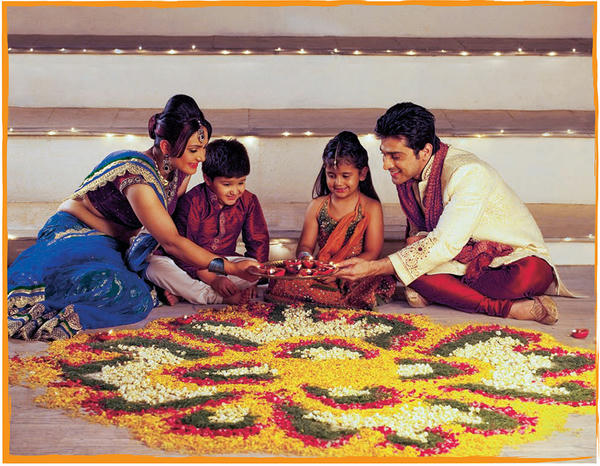19 What Is the Nature of Life for Saivites?§
Here a father and mother hold a tray of small lamps to teach their children the meaning of the dipa, the light that removes darkness. Earlier the four created the kolam design before them with colorful flower petals.§
SHUTTERSTOCK§
All people seek the same things in life. They want to be happy and secure, loved and appreciated, creative and useful. Saivism has a rich and gentle culture that fulfills these human wants. It has profound teachings that help us understand the world and our place in it. It gives guidance in the refined qualities of character so necessary in spiritual life: how to be patient, kind, tolerant, humble, hard-working and devoted. Saivism centers around the home and the temple. Monastic life is its core and power. Family life is strong and precious. Mother and father are a child’s first gurus. Saivism possesses a wealth of art and architecture. It has beautiful traditions of music, art, drama and dance. It has a treasury of philosophy and scholarship. Saivite temples provide worship services daily. They are sacred places where devotees find peace and closeness with God. Festivals are fun for the whole family. Scriptures help us to know ourself, live a good life and love God. Our holy men and women teach us yoga and ways of worship. They inspire us in everything we do and give us daily sadhana, which are our spiritual studies and disciplines. Performing sadhana helps us control our instinctive impulses and live a pure and happy life. To the Saivite Hindu, all of life is sacred. All of life is religion. Thus, Saivite art is sacred art, Saivite music is devotional music, and the Saivite’s business is not only his livelihood, it is his service to man and God. You are so fortunate to be a Saivite Hindu. Stand strong for Saivism.§
GURUDEVA: Saivism’s grandeur and beauty are found in a practical culture, an enlightened view of man’s place in the universe and a profound system of temple mysticism and siddha yoga.§

